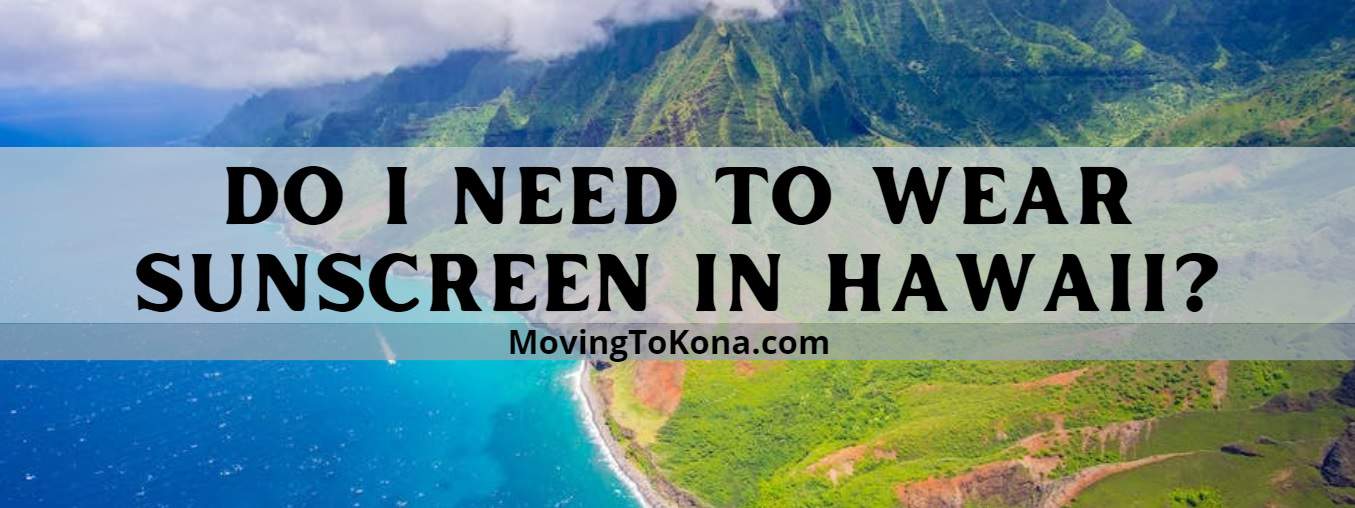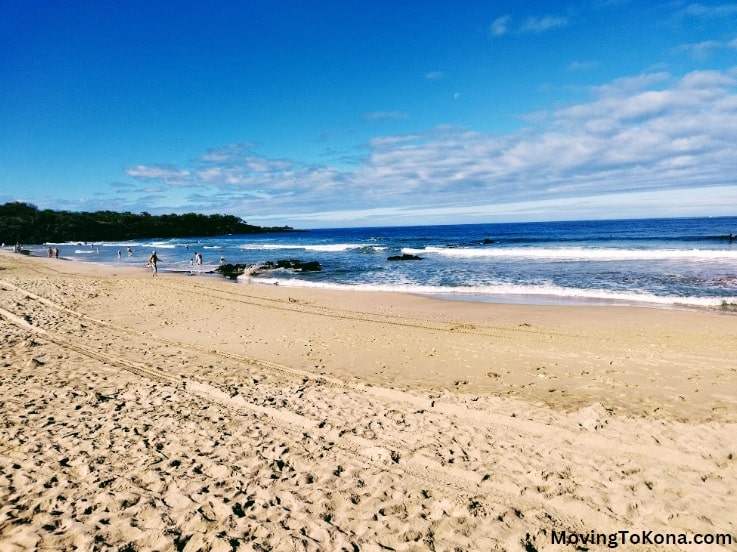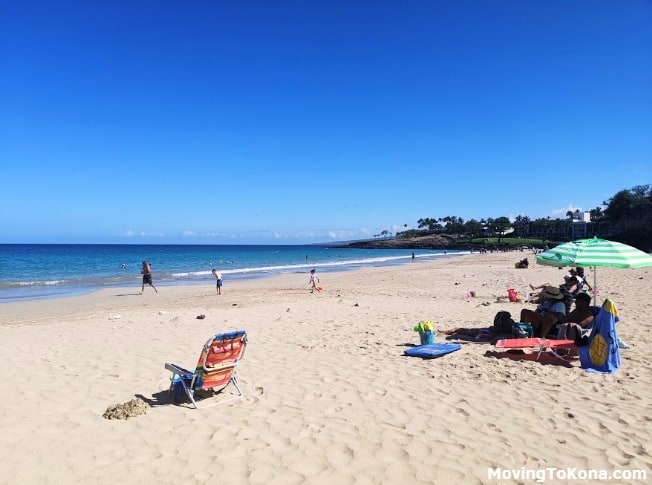Do I Need to Wear Sunscreen in Hawaii?

How Much Sun Do You Get in Hawaii?
Have you ever wondered how much sun you get in Hawaii? The answer is a lot – in a typical year, Honolulu will have 70% of days with sun! With the nearness of Hawaii to the equator, the sun’s rays are a lot stronger here than in other places, so it’s essential to wear proper protection against UV rays. The mid-day sun is especially intense throughout the entire year, with 10am to 2pm being the prime time to be extra diligent about sunscreen application. It’s important to note that even on partly cloudy or cloudy days, you can still get sunburned, so it’s best to wear sunscreen every day to protect your skin.

Reef-Safe Sunscreens
- Reef Safe Sunscreen SPF 50 All Natural
- Sunscreen Spray by Florida Suncare
- BLUE LIZARD Sensitive Mineral Sunscreen
- Sun Bum Original SPF 50
- Solimo Sport Sunscreen Lotion, SPF 50
What are the Benefits of Wearing Sunscreen in Hawaii?
1. Sunscreen protects the skin from harmful ultraviolet rays.
Sunscreen protects the skin from harmful ultraviolet rays by absorbing, reflecting, or scattering the sun’s rays. Sunscreen with a sun protection factor (SPF) of at least 30 is recommended to provide a good level of protection. In addition to sunscreen, wearing hats with a three- to four-inch brim, protective clothing, and UV-blocking sunglasses are also important measures to protect the skin from UV radiation. Sunscreens that are mineral-based, such as zinc oxide and titanium dioxide, provide the best protection as they block the sun’s rays without the use of chemical ingredients. Avoiding sunscreen altogether and wearing sun protective apparel are also effective ways to protect the skin.
2. Sunscreen decreases the risk of sunburn and skin damage.
Sunscreen can decrease the risk of sunburn and skin damage when in Hawaii by providing a physical barrier between the skin and the sun’s harmful UV rays. Proper use of sunscreen can help protect the skin from sunburn, skin cancer, and premature aging. To maximise protection, it is important to find a sunscreen with a sun protection factor (SPF) of at least 30 that contains ingredients such as zinc oxide, titanium dioxide, and avobenzone, with a stabilizing molecule such as helioplex. It is also important to put the sunscreen on correctly, at least thirty minutes before going out in the sun, and re-apply every two hours, more frequently if swimming or sweating. Furthermore, it is recommended to wear a wide brimmed hat, protective clothing, and UV-blocking sunglasses, and to seek shade when possible. By following these precautions, people can decrease their risk of suffering the damaging effects of sun exposure.
3. Sunscreen increases the chance of having a good beach day.
Wearing sunscreen greatly increases the chance of having a good beach day. Sunscreen helps protect the skin from the damaging effects of ultraviolet (UV) light, which can cause sunburn, premature aging, and skin cancer. A sun protection factor (SPF) of at least 30 is recommended for maximum protection. Applying sunscreen at least 30 minutes before going outdoors and reapplying every two hours, or more frequently if swimming or sweating, is essential. Additionally, hats, protective clothing, and sunglasses with UV-blocking lenses can offer additional protection. By taking all the necessary steps to protect the skin, people can enjoy the beach without the worry of sunburn or other sun-related skin damage.
4. Sunscreen can be used to protect against the risk of skin cancer.
Sunscreen can help to protect against the risk of skin cancer in Hawaii by blocking out the dangerous UVA and UVB radiation from the sun. Sunscreen should have an SPF of at least 30, and should be applied at least 30 minutes before going outdoors. Additional protection can be provided by wearing a hat with a three to four inch brim, UV-blocking sunglasses and protective clothing with a tighter weave. People should also avoid sunscreens that contain Oxybenzone, Butylparaben, Octinoxate, and 4-Methylbenzylidine Camphor, and opt for reef-safe products that have been rated highly by the Environmental Working Group (EWG) such as Thinksport, Kiss My Face Organics, Badger, and ThinkBaby Safe Sunscreen. By following these steps, people can help to reduce their risk of skin cancer while enjoying the beauty of Hawaii.
5. Sunscreen can be used to protect against the risk of coral reef damage.
Sunscreen can help protect coral reefs in Hawaii by preventing damaging chemicals from entering the ocean. Sunscreens with ingredients such as mineral-based barriers help preserve the Hawaiian waters and prevent bleaching, DNA injury, starvation, and reproductive and development issues in the coral reefs. By using reef-safe sunscreen alternatives that don’t contain any dangerous chemicals, visitors can help reduce the amount of sunscreen entering the ocean and limit the threats to the coral reefs. With Hawaii’s millions of visitors, the use of reef-safe sunscreen can help preserve our marine ecosystems and prevent property damage and loss of life.

What Does Reef-Safe Sunscreen Mean?
Reef-safe sunscreen is sunscreen that does not contain chemicals oxybenzone or octinoxate, which are known to be damaging to coral reefs and other marine life. These chemicals are banned in certain states, such as Hawaii and Florida, and have been identified by the National Oceanic and Atmospheric Administration (NOAA) as ingredients to avoid. Reef-safe sunscreen typically contains zinc oxide and titanium dioxide as active ingredients, which provide broad-spectrum protection from both UVA and UVB rays. These minerals work by reflecting and scattering sunlight away from the skin, rather than absorbing it like chemical sunscreens do. Reef-safe sunscreens are also usually free of other harmful ingredients such as parabens, phthalates, and synthetic fragrances, making them gentler on the skin.
What Ingredients are Used in Reef-Safe Sunscreen?
Reef-safe sunscreen typically contains zinc oxide and titanium dioxide as the active ingredients. These minerals provide broad-spectrum protection from both UVA and UVB rays by reflecting and scattering sunlight away from the skin, rather than absorbing it like chemical sunscreens. Additionally, reef-safe sunscreens should be free of other harmful chemicals such as parabens, phthalates, and synthetic fragrances. Non-nano zinc oxide is often used as an active ingredient due to its ability to provide broad-spectrum SPF 30 protection. Other ingredients found in reef-safe sunscreens may include mineral oil, antioxidant vitamins A and C, and biodegradable ingredients. Finally, it is important to avoid sunscreens with chemicals such as oxybenzone and octinoxate, as these are banned in Hawaii and can be damaging to coral reefs.
Is There a Sunscreen Ban in Hawaii?
Yes, there is a sunscreen ban in Hawaii. This ban prohibits the sale of sunscreen products that contain certain chemicals deemed harmful to the coral reefs and marine life. Additionally, enforcement of the law means that stores should no longer have any products that are not reef-safe. Tourists are still able to bring their own sunscreen into Hawaii, but they should make sure it is reef-safe and mineral-based. Failure to do so could harm the sensitive coral reefs and sea life of the Hawaiian islands.
What is the Best Reef-Safe Sunscreen to Use in Hawaii?
When visiting Hawaii, it’s important to protect yourself from the sun by using a reef-safe sunscreen. Traditional sunscreens contain harmful chemicals that can damage coral reefs, so it’s important to choose one that is environmentally-friendly. With all of the available sunscreen options, it can be hard to know which one is best.
At the top of the list is Sun Bum Mineral Sunscreen, which is designed to protect skin without harming the environment. It is a reef-safe sunscreen that is compliant with the Hawaii Sunscreen Ban. It also offers UVA and UVB protection, is water-resistant, and contains no parabens, oils, or fragrances.
Next is Neutrogena Sheer Zinc Mineral Sunscreen, which offers protection from the sun’s UVA rays. It is hypoallergenic and free from fragrance, oils, and other forms of irritation. Additionally, it is water-resistant for up to 80 minutes.
Aveeno Positively Mineral Sensitive Skin Sunscreen is another reef-safe sunscreen that is free from fragrances and oils. It is also water-resistant for up to 80 minutes, and offers broad-spectrum protection from UVA and UVB rays.
Thinksport Safe Sunscreen is a reef-safe sunscreen that is compliant with the Hawaii Sunscreen Ban. It offers broad spectrum UVA and UVB protection and is water-resistant for up to 80 minutes. It is also free from fragrances, oils, and other forms of irritation.
Finally, Hawaiian Tropic does have reef-safe sunscreen options, but you have to look carefully at the active ingredients. For example, one Hawaiian Tropic sunscreen is labeled reef-friendly and is ok in Hawaii, but would NOT be legal in Maui County or Hawaii County.
Overall, the best reef-safe sunscreen to use in Hawaii is Sun Bum Mineral Sunscreen. It is designed to protect skin without harming the environment, offers UVA and UVB protection, and is water-resistant. It also contains no parabens, oils, or fragrances. Neutrogena Sheer Zinc Mineral Sunscreen, Aveeno Positively Mineral Sensitive Skin Sunscreen, Thinksport Safe Sunscreen, and Hawaiian Tropic all offer reef-safe options as well.
What is the SPF Rating of Reef-Safe Sunscreen?
Reef-safe sunscreen is any sunscreen that does not contain chemicals that are toxic and damaging to marine life. The most common ingredient used in reef-safe sunscreen is non-nano zinc oxide, which is considered to be the safest option for coral reefs. The SPF rating indicates the level of protection a sunscreen provides against the harmful UV rays. A sunscreen with an SPF rating of 30 means it will block 97% of the UVB rays, whereas an SPF rating of 50 will block 98% of the UVB rays. It is important to note that no sunscreen will protect you 100% from UV rays, so it is important to reapply every two hours, wear protective clothing, and stay out of the sun during peak hours.
What are the Effects of Sunscreen on Coral Reefs?
The effects of sunscreen on coral reefs are numerous and detrimental. Sunscreens containing chemicals like oxybenzone and octinoxate can cause coral bleaching, DNA damage, starvation, reproductive and development issues, and coral mortality. These chemicals can also degrade a coral’s resiliency and ability to adjust to climate change factors. In addition, they can inhibit the recruitment of new coral. These effects are so severe that in 2018, Hawaii became the first U.S. state to pass a bill banning sunscreens that contain these chemicals.
What are the Differences Between Mineral and Chemical Sunscreens?
The main difference between mineral and chemical sunscreens is the way in which they protect the skin from UV rays. Mineral sunscreens, such as zinc oxide and titanium dioxide, work by deflecting and scattering UV rays away from the skin, while chemical sunscreens absorb the UV rays and convert them to heat. Both types of sunscreen are effective, but many manufacturers make the minerals in mineral-based sunscreens nano size, which can be damaging to reefs. Additionally, Consumer Reports has yet to find a mineral-based sunscreen that meets both UVA and UVB protection and the advertised SPF.
Chemical sunscreens contain active ingredients such as oxybenzone, avobenzone, octisalate, octocrylene, homosalate, and octinoxate, which act as UV filters. Studies have not yet been conducted to prove that these chemicals damage reefs, but are still recommended to avoid. Baby coral exposed to oxybenzone and octinoxate have shown signs of distress, such as coral bleaching, DNA damage, and irregularities in their growth and skeleton.
Overall, both mineral and chemical sunscreens are effective in protecting against UV rays, but mineral-based sunscreens are recommended for reef-safe versions and to avoid potential damage to the ocean.

Are There any Reef-Safe Sunscreen Options Available in Hawaii?
Yes, there are reef-safe sunscreen options available in Hawaii. The state recently passed a law banning sunscreens containing oxybenzone and octinoxate, two common ingredients in traditional sunscreens. Many brands now offer reef-safe sunscreens that follow Hawaii’s regulations and protect your skin without harming the environment. When choosing a reef-safe sunscreen, look for labels reading “Reef Safe” or “Reef Friendly,” or check the listed ingredients. Also, make sure to purchase mineral sunscreens with active ingredients such as zinc oxide and titanium dioxide.
What are the Consequences of Not Wearing Sunscreen in Hawaii?
The consequences of not wearing sunscreen in Hawaii can be severe due to the intensity of the sun’s UV rays. Not wearing sunscreen can result in sunburn, brown spots, wrinkles, and potentially skin cancer. Not wearing sunscreen every day, even on cloudy days, can increase a person’s risk of sun damage. Additionally, some sunscreens contain harmful chemicals that can damage coral reefs and marine life, which could have serious consequences for Hawaii’s ecosystem. Therefore, it is important to wear reef-safe mineral sunscreen when visiting Hawaii in order to protect your skin and the environment.
Are There any Hawaii State Laws Regarding Wearing Sunscreen?
Yes, there are Hawaii state laws regarding sunscreen. In 2018, Governor David Ige signed a law banning sunscreens that contain oxybenzone or octinoxate without a prescription issued by a healthcare provider in order to protect marine ecosystems. Beginning January 1, 2021, it is illegal to sell, offer for sale, or distribute any sunscreen that contains these chemicals in the state of Hawaii. Furthermore, Maui County has its own law banning the use of non-mineral sunscreen, effective October 1, 2022. Consequently, it is important to bring reef-safe sunscreens when visiting Hawaii in order to protect the fragile coral reefs and sea life of the Aloha state.
